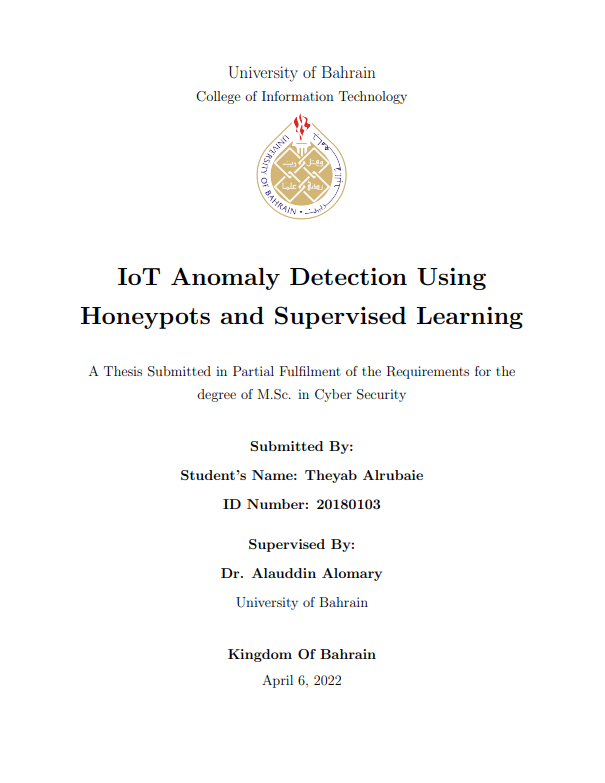Document
Deep Clustering for IoT Anomaly Detection and Device Identification
Linked Agent
Al-Ammal, Hesham , Thesis advisor
Al-Junaid, Hessa , Thesis advisor
Date Issued
2023
Language
English
Extent
14, 85, [1]
Subject
Place of institution
Bahrain, Skhair
Thesis Type
Thesis (Master)
Institution
University of Bahrain , College of Information Technology, Department of Computer Science
English Abstract
Abstract:
IoT devices are small physical objects that can communicate through a specific network. IoT employment has demonstrated substantial growth in the past years specifically during Covid-19 pandemic. A key pursuit for the IoT market is to support vital sectors with new sophisticated technology such as health and education specially in smart cities such as Shanghai, Seoul, and New York. As the use of IoT devices continues to grow, the demand for effective anomaly detection and device identification solutions is likely to increase. IoT networks and devices can be vulnerable against cyber-attacks because of IoT device's characteristics such as limited computational power, memory, and battery life. Because of such features, it is challenging to implement advanced identification schemes.
This thesis aims to implement automated IoT anomaly detection and device identification scheme using deep clustering algorithms. The significate of the research comes from the urgent need for powerful identification models that can cope with IoT changing devices and environment and to be able to detect known and unknown anomalies and devices. The scope of this thesis's experiments is to investigate both classification and clustering algorithms to detect anomalies and identify IoT devices. Several machine learning and deep learning algorithms were selected based on performance and effectiveness. All algorithms were trained and tested using two public IoT datasets, namely CIC-IoT-2022 and IoT23. For classification purposes, the selected algorithms were Convolutional Neural Network (CNN), Artificial Neural Network (ANN), Random Forest (RF), Decision Tree (DT), and K-nearest Neighbor (KNN). For clustering purposes, the selected algorithms were K-Means (KM), Deep Clustering Network (DCN), Deep Embedding Clustering (DEC), and Dynamic Auto-Encoder (DynAE). The performance of the applied algorithms was evaluated using several evaluation measures such as confusion matrix and Normalized Mutual Information (NMI). It was concluded that the DynAE algorithm is the most effective deep clustering algorithm with 81% accuracy on IoT23 malware dataset.
Note
Title on cover:
توظيف خوارزميات العنقدة العميقة في تصنيف ورصد الحالات الشاذة في أجهزة إنترنت الأشياء
توظيف خوارزميات العنقدة العميقة في تصنيف ورصد الحالات الشاذة في أجهزة إنترنت الأشياء
Member of
Identifier
https://digitalrepository.uob.edu.bh/id/c564c661-c3a6-4033-b769-3d377437ce2c
Same Subject
